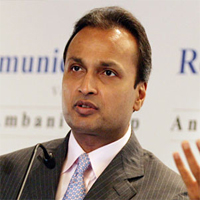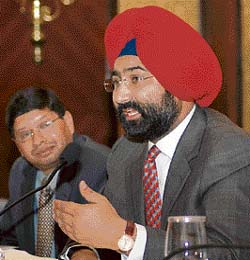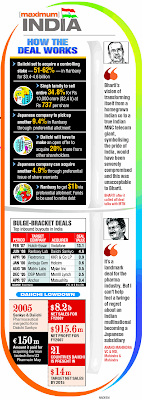 MTN Team In Mumbai To Start Due Diligence
MTN Team In Mumbai To Start Due Diligence
Piyush Pandey & Bodhisatva Ganguli THE WEEKEND saw no let-up in the latest round of the seemingly unending and relentless war between the Ambani brothers, with both sides readying their heaviest legal artillery. After the initial shock and awe of RIL’s sudden intervention, Anil Dhirubhai Ambani Group (ADAG) officials have adopted an aggressive posture. However, RIL shows no signs of yielding with company officials claiming that MTN would have to consider the legal implications of acquiring RCom. Seemingly undeterred by the controversy, an MTN team arrived in Mumbai on Saturday to start due diligence on RCom.
Speaking to ET on Sunday, a senior ADAG executive said Reliance Industries (RIL) can make an open offer if they are keen on buying Reliance Communications (RCom). The executive is involved in structuring the proposed $70-billion mega merger deal between Reliance Communications and South African Telecom giant MTN.
“If they want, they can make an open offer to buy RCom or go to the court. They will not do so or go to court because they are not interested in buying RCom, but their only interest is to sabotage our efforts to create a global telecom giant stretching from Asia to the Middle East and Africa with a subscriber base of 116 million,” said the executive.
“Besides, what is hurting RIL is that, if the deal goes through, the combined EBITDA of the combined RCom and MTN for 2009 would be Rs 45,000 crore, 50% more than RIL’s EBITDA of Rs 30,000 crore. Our deal is on track,” said the executive. Have to take note of our concerns,says RIL
WHEN asked for comments on RIL making an open offer to buy RCom or going to court to seek it’s right of first refusal, RIL’s official spokesperson declined to comment saying that RIL has not officially received any response from RCom or MTN for it’s letter. “It’s interesting that they have not responded to us even after 48 hours. As far as MTN is concerned, their board and all bankers involved will have to take note of concerns expressed by India’s largest private sector company,” an RIL source said.
In a statement issued to media on Friday, RIL had said, “RIL has in good faith notified both Anil Dhirubhai Ambani Group and MTN of the stipulations contained in an agreement, the validity of which has never been questioned so far by ADAG.”
When asked if RCom has received any communication from MTN asking for clarifications on RIL’s letter, the RCom executive said, “MTN was quick enough to respond to RIL’s letter. Within a couple of hours, MTN official spokesperson had said nothing has really changed and talks with RCom were on as per the 45 days exclusive talks agreement.” MTN officials could not be reached for their comments.
The issue came into the limelight after RIL wrote to MTN on Thursday threatening legal proceedings to enforce its claimed right of first refusal in the Bombay High Court, in which case, MTN would also be one of the defendants.
RIL’s letter to MTN was addressed to Cyril Ramaphosa,(non-executive chairman) and P F Nhelko (group president and CEO). The letter, a copy of which is available with ET said, “As you will note, we have already notified to ADAG that we shall adopt legal proceedings against them in the Bombay High Court in which we shall necessarily add MTN as one of the defendants.” “Please note that any agreement of the nature contemplated above between MTN and ADAG will result in MTN procuring a breach of the agreement, which shall entitle RIL to make a claim for exemplary damages against MTN,” said the letter.
The letter was written by RIL’s company secretary K Sethuraman and the copies of the letter were marked to the investment bankers involved in the deal such as Lombard Odier Darier & Cie, Newshelf664, Merill Lynch South Africa, Myrill Lynch, Lazard Limited and Deutsche Bank’s offices in the UK and Germany.
Commenting on the letter, the ADAG executive said, “As far as RIL going to the court is concerned, they may, but on what basis? On the basis of the January 12, 2006 agreement, which was unilaterally signed by RIL officials and which subsequently the Bombay High Court has ruled as ‘unfair and unjust’
in October 2007.” The ADAG executive also said that RIL had “jumped the gun” since no definitive agreement had been reached with MTN.
The crux of the younger Ambani’s case is that, the implementation of the MoU signed in July 2005 to execute the family settlement was done in a faulty manner. The MoU envisaged the creation of two groups — MDA and ADA. The MoU further said that the group companies would enter into various agreements such as right of first refusal, non-compete and so on. RCom officials allege that these agreements were in fact signed on January 12, 2006, when the future ADA companies (RCom, Reliance Energy, Reliance Capital) were still part of the original Reliance Group controlled by Mukesh Ambani. They were handed over to ADA only in February 2006. They say that agreements should have been signed only after ADAG was created. Instead, Mukesh Ambani entities had signed agreements with each other ignoring ADAG’s interests.
The same legal issue has taken centrestage in ongoing legal proceedings in the Bombay High Court, though the dispute here relates to the ADA Group’s right over gas supply to its power plants. A single judge bench has ruled that RIL could not sign binding gas supply agreements without first ensuring ADA’s rights. The case is now before a division bench. The government of India (GOI) has supported RIL’s right to sign gas supply agreements, saying that this was in the national interest. The division bench has not delivered a final verdict. Whoever loses is sure to go to the Supreme Court.
If the RCom-MTN case goes to the court, then, an opinion by the Attorney General of India relating to Balco, may also be of relevance. RCom officials reason there can be no restriction on ADAG’s right to sell its shares in RCom. More so, since the right of first refusal is not part of RCom’s articles of association.
Commenting on the validity of the agreement, an RCom spokesperson said, “RIL’s reference to an agreement dated January 12, 2006, is misleading, as ADAG has written to RIL the very same day, and rejected the unilateral procedure adopted for finalising such agreements as being illegal. Further, these were never incorporated in articles of association of ADAG companies.”
But RIL sources rubbish these contentions. “The master agreement of January 2006 was approved by the RIL board, of which, Anil Ambani was a very much a part. The agreement gave birth to ADAG. Further, the non-compete clauses of the same agreement is often used by ADAG to challenge and block many MDA initiatives. The latest such challenge was the plan to set up power plants in the Navi and Maha Mumbai SEZs,” a source said. “We get letters from them (ADA) every two weeks on something or the other, but we keep quiet. How can they now repudiate the agreement?” the source said.
Perhaps, its time for family matriarch Kokilaben to intervene once again.




























